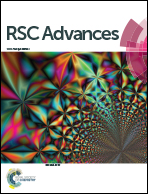Recovery of solid sulfur from hydrogen sulfide gas by an electrochemical membrane cell†
Abstract
Sulfides are hazardous chemicals which endanger the lives of humans. Electrochemical oxidation of sulfides is a predominant method for sulfur removal from wastewater. A major limitation of the electrochemical method of sulfur removal is the deposition of sulfur on the anode surface which retards the electrochemical reaction. In the present study, sulfides were oxidized consequently in an electrochemical membrane process to generate elemental sulfur in a powdered form. Sulfide oxidation was achieved by employing flattened and standard titanium substrate insoluble anode (TSIA) meshes with low energy inputs (20 mA cm−2). The shape of the electrode (standard) consequently determines the electrochemical oxidation of the metal sulphide. The irreversible reaction of the sulfide oxidation reaction was explained by a cyclic voltammetry study. This investigation explains that the current distribution of the standard TSIA may be the reason for the sulfur recovery process by an electrochemical membrane reactor, and the recovered product was confirmed through X-ray diffraction and Raman spectroscopy. The spherical shape of the sulfur particles was observed by field emission scanning electron microscopes (FE-SEM and EDAX).


 Please wait while we load your content...
Please wait while we load your content...